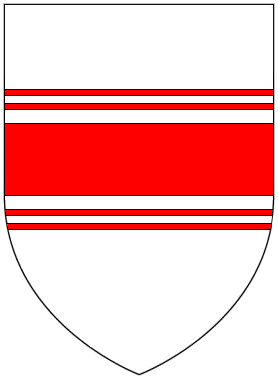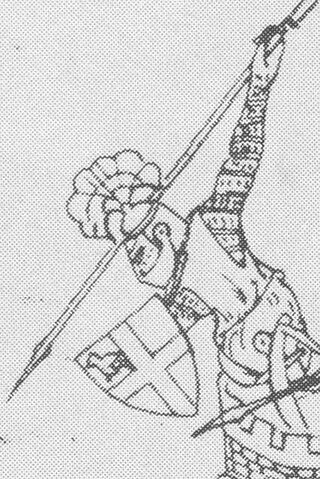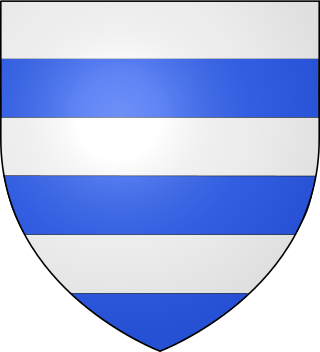
Bartholomew de Badlesmere, 1st Baron Badlesmere was an English soldier, diplomat, member of parliament, landowner and nobleman. He was the son and heir of Sir Gunselm de Badlesmere and Joan FitzBernard. He fought in the English army both in France and Scotland during the later years of the reign of Edward I of England and the earlier part of the reign of Edward II of England. He was executed after participating in an unsuccessful rebellion led by Thomas, 2nd Earl of Lancaster.
Thomas of Lancaster, 2nd Earl of Lancaster, 2nd Earl of Leicester, 2nd Earl of Derby, jure uxoris 4th Earl of Lincoln and jure uxoris 5th Earl of Salisbury was an English nobleman. A member of the House of Plantagenet, he was one of the leaders of the baronial opposition to his first cousin, King Edward II.

Andrew Harclay, 1st Earl of Carlisle, alternatively Andreas de Harcla, was an important English military leader in the borderlands with Scotland during the reign of Edward II. Coming from a knightly family in Westmorland, he was appointed sheriff of Cumberland in 1311. He distinguished himself in the Scottish Wars, and in 1315 repulsed a siege on Carlisle Castle by Robert the Bruce. Shortly after this, he was taken captive by the Scots, and only released after a substantial ransom had been paid. His greatest achievement came in 1322, when he defeated the rebellious baron Thomas of Lancaster at the Battle of Boroughbridge on 16–17 March. For this he was created Earl of Carlisle.

Edmund Fitzalan, 2nd Earl of Arundel was an English nobleman prominent in the conflict between King Edward II and his barons. His father, Richard Fitzalan, 1st Earl of Arundel, died in 1302, while Edmund was still a minor. He, therefore, became a ward of John de Warenne, Earl of Surrey, and married Warenne's granddaughter, Alice. In 1306 he was styled Earl of Arundel, and served under Edward I in the Scottish Wars, for which he was richly rewarded.

Henry, 3rd Earl of Leicester and Lancaster was a grandson of King Henry III of England (1216–1272) and was one of the principals behind the deposition of King Edward II (1307–1327), his first cousin.

Guy de Beauchamp, 10th Earl of Warwick was an English magnate, and one of the principal opponents of King Edward II and his favourite, Piers Gaveston. Guy was the son of William de Beauchamp, the first Beauchamp earl of Warwick, and succeeded his father in 1298. He distinguished himself at the Battle of Falkirk and subsequently, as a capable servant of the crown under King Edward I. After the succession of Edward II in 1307, however, he soon fell out with the new king and the king's favourite, Piers Gaveston. Warwick was one of the main architects behind the Ordinances of 1311, that limited the powers of the king and banished Gaveston into exile.

Aymer de Valence, 2nd Earl of Pembroke was an Anglo-French nobleman. Though primarily active in England, he also had strong connections with the French royal house. One of the wealthiest and most powerful men of his age, he was a central player in the conflicts between Edward II of England and his nobility, particularly Thomas, 2nd Earl of Lancaster. Pembroke was one of the Lords Ordainers appointed to restrict the power of Edward II and his favourite Piers Gaveston. His position changed with the great insult he suffered when Gaveston, as a prisoner in his custody whom he had sworn to protect, was removed and beheaded at the instigation of Lancaster. This led Pembroke into close and lifelong cooperation with the king. Later in life, however, political circumstances combined with financial difficulties would cause him problems, driving him away from the centre of power.
Humphrey (VII) de Bohun, 4th Earl of Hereford was a member of a powerful Anglo-Norman family of the Welsh Marches and was one of the Ordainers who opposed Edward II's excesses.

Robert de Holland, 1st Baron Holand was an English nobleman, born in Lancashire.

The Battle of Old Byland was a significant encounter between Scots and English troops in Yorkshire in October 1322, forming part of the Wars of Scottish Independence. It was a victory for the Scots, the most significant since Bannockburn.
Eustace Folville is credited with killing/assassinating the unpopular Sir Roger de Beler, Baron of the Exchequer and henchman of the despised Hugh le Despencer and ineffective King Edward II. He was the most active member of the Folville Gang who engaged in acts of vigilantism and outlawry in Leicestershire in the early 1300s, often on the behalf of others.
The Ordinances of 1311 were a series of regulations imposed upon King Edward II by the peerage and clergy of the Kingdom of England to restrict the power of the English monarch. The twenty-one signatories of the Ordinances are referred to as the Lords Ordainers, or simply the Ordainers. English setbacks in the Scottish war, combined with perceived extortionate royal fiscal policies, set the background for the writing of the Ordinances in which the administrative prerogatives of the king were largely appropriated by a baronial council. The Ordinances reflect the Provisions of Oxford and the Provisions of Westminster from the late 1250s, but unlike the Provisions, the Ordinances featured a new concern with fiscal reform, specifically redirecting revenues from the king's household to the exchequer.
Margaret de Badlesmere, Baroness Badlesmere was a Anglo-Norman noblewoman, suo jure heiress, and the wife of Bartholomew de Badlesmere, 1st Baron Badlesmere.
The Despenser War (1321–22) was a baronial revolt against Edward II of England led by the Marcher Lords Roger Mortimer and Humphrey de Bohun. The rebellion was fuelled by opposition to Hugh Despenser the Younger, the royal favourite. After the rebels' summer campaign of 1321, Edward was able to take advantage of a temporary peace to rally more support and a successful winter campaign in southern Wales, culminating in royal victory at the Battle of Boroughbridge in the north of England in March 1322. Edward's response to victory was his increasingly harsh rule until his fall from power in 1326.

The 1322 Battle of Burton Bridge was fought between Thomas, 2nd Earl of Lancaster and his cousin King Edward II of England during the Despenser War. Edward's army was proceeding northwards to engage Lancaster, having defeated his Marcher Lord allies in Wales. Lancaster fortified the bridge at Burton upon Trent, an important crossing of the River Trent, in an attempt to prevent the King from proceeding. Edward arrived at nearby Cauldwell on 7 March 1322 and intended to use the ford at Walton-on-Trent to cross the river and outflank Lancaster. Edward was delayed for three days by floodwaters, during which time some of his force was deployed opposite Lancaster's men at the bridge.
Stephen Devereux of Bodenham and Burghope was a member of a prominent knightly family in Herefordshire during the reigns of Edward I, Edward II and Edward III. An important retainer of the de Bohun Earls of Hereford, he gave rise to the Devereux Earls of Essex and Viscounts of Hereford.
Sir William Trussell was an English politician and leading rebel in Queen Isabella and Roger Mortimer, 1st Earl of March's rebellion against Edward II. William acted as Speaker of the House of Commons and renounced the allegiance of England to Edward II, forcing his abdication, and became King Edward III's Secretary.

Sir John de Kingston Lord of Kingston Bagpuize and Little Sutton was an English knight of the late 12th and early 13th centuries from Berkshire and Wiltshire. He fought in the wars in Wales, Flanders and Scotland. He was a signatory of the Baron's Letter to Pope Boniface VIII in 1301.

Richard Grey, 2nd Baron Grey of Codnor, of Codnor Castle, was an English soldier and diplomat.










